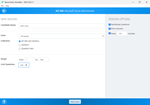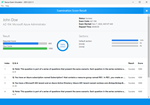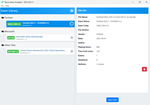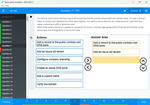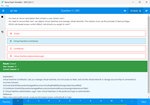Download Professional Scrum with Kanban.PSK-I.VCEplus.2025-03-21.26q.tqb
| Vendor: | Scrum |
| Exam Code: | PSK-I |
| Exam Name: | Professional Scrum with Kanban |
| Date: | Mar 21, 2025 |
| File Size: | 104 KB |
How to open TQB files?
Files with TQB (Taurus Question Bank) extension can be opened by Taurus Exam Studio.
Purchase
Coupon: TAURUSSIM_20OFF
Discount: 20%
Demo Questions
Question 1
For teams practicing Professional Scrum with Kanban, what are the most appropriate metrics to inspect?
(choose the best answer)
- Control Chart, CFD and Aging Chart.
- Story points and historical velocity.
- User stories t-shirt size.
- All of the answers.
- None of these are Kanban for Scrum Teams metrics.
Correct answer: A
Explanation:
For teams practicing Professional Scrum with Kanban, the most appropriate metrics to inspect are:Control Chart: This chart helps visualize process stability and identify any significant deviations from the expected behavior. By tracking key metrics like lead time and cycle time, teams can identify trends and potential issues.Cumulative Flow Diagram (CFD): The CFD provides a visual representation of the flow of work through the system. It helps teams understand bottlenecks, identify areas for improvement, and assess the overall health of their workflow.Aging Chart: This chart shows the age of work items as they progress through the workflow. It helps teams identify items that are taking too long to complete and prioritize them accordingly. These metrics are particularly relevant for Kanban teams because they focus on the flow of work and the identification of bottlenecks. By tracking these metrics, teams can make data-driven decisions to optimize their workflow and improve delivery performance.Options B, C, and D are not the most appropriate metrics for Kanban teams. Story points and historical velocity are more commonly used in Scrum, while t-shirt size is a relative estimation technique that may not be suitable for all Kanban teams. For teams practicing Professional Scrum with Kanban, the most appropriate metrics to inspect are:
Control Chart: This chart helps visualize process stability and identify any significant deviations from the expected behavior. By tracking key metrics like lead time and cycle time, teams can identify trends and potential issues.
Cumulative Flow Diagram (CFD): The CFD provides a visual representation of the flow of work through the system. It helps teams understand bottlenecks, identify areas for improvement, and assess the overall health of their workflow.
Aging Chart: This chart shows the age of work items as they progress through the workflow. It helps teams identify items that are taking too long to complete and prioritize them accordingly.
These metrics are particularly relevant for Kanban teams because they focus on the flow of work and the identification of bottlenecks. By tracking these metrics, teams can make data-driven decisions to optimize their workflow and improve delivery performance.
Options B, C, and D are not the most appropriate metrics for Kanban teams. Story points and historical velocity are more commonly used in Scrum, while t-shirt size is a relative estimation technique that may not be suitable for all Kanban teams.
Question 2
Which of these statements are true about Kanban and the Scrum theory of empiricism?
(choose the best two answers)
- The Kanban board provides Scrum Teams with transparency that helps them inspect and adapt their process.
- Kanban metrics are used in the Sprint Review to allow the Product Owner to inspect the Throughput and adapt the Scrum Team's Cycle Time.
- Kanban helps Scrum Teams deal with simple and complicated work where empiricism is not necessary.
- Kanban helps Scrum Teams achieve faster, healthier flow. That brings more rapid transparency about the product, enabling a more effective inspection and adaptation loop.
Correct answer: AD
Explanation:
1. The Kanban Board Provides Transparency (Option A):A Kanban board visualizes the flow of work, making it easy for the Scrum Team to see the status of work items, identify bottlenecks, and inspect and adapt their processes. This visual transparency is a fundamental aspect of both Scrum and Kanban and supports the empirical process control central to Scrum(2. Kanban Helps Achieve Faster, Healthier Flow (Option D):By focusing on optimizing flow (e.g., reducing Cycle Time and managing Work in Progress), Kanban helps Scrum Teams achieve a faster, more predictable flow of work. This improvement in flow brings more rapid transparency, allowing for more effective inspection and adaptation during Scrum events such as the Daily Scrum, Sprint Review, and Sprint Retrospective(Option B (Kanban metrics are used in the Sprint Review to allow the Product Owner to inspect Throughput and adapt the Scrum Team's Cycle Time) is not necessarily accurate, as the Sprint Review focuses on the product increment and stakeholder feedback, not directly on Kanban metrics.Option C (Kanban helps Scrum Teams deal with simple and complicated work where empiricism is not necessary) is incorrect because both Kanban and Scrum rely on empiricism (transparency, inspection, and adaptation) to deal with work complexity 1. The Kanban Board Provides Transparency (Option A):
A Kanban board visualizes the flow of work, making it easy for the Scrum Team to see the status of work items, identify bottlenecks, and inspect and adapt their processes. This visual transparency is a fundamental aspect of both Scrum and Kanban and supports the empirical process control central to Scrum(
2. Kanban Helps Achieve Faster, Healthier Flow (Option D):
By focusing on optimizing flow (e.g., reducing Cycle Time and managing Work in Progress), Kanban helps Scrum Teams achieve a faster, more predictable flow of work. This improvement in flow brings more rapid transparency, allowing for more effective inspection and adaptation during Scrum events such as the Daily Scrum, Sprint Review, and Sprint Retrospective(
Option B (Kanban metrics are used in the Sprint Review to allow the Product Owner to inspect Throughput and adapt the Scrum Team's Cycle Time) is not necessarily accurate, as the Sprint Review focuses on the product increment and stakeholder feedback, not directly on Kanban metrics.
Option C (Kanban helps Scrum Teams deal with simple and complicated work where empiricism is not necessary) is incorrect because both Kanban and Scrum rely on empiricism (transparency, inspection, and adaptation) to deal with work complexity
Question 3
Upon which of the five Scrum Values does Professional Scrum with Kanban build?
(choose the best three answers)
- Courage.
- Transparency.
- Focus.
- Openness.
- Professionalism.
Correct answer: ACD
Explanation:
Professional Scrum with Kanban builds upon the core Scrum values to enhance flow and effectiveness within the team. The relevant values are:Courage: Encourages team members to address issues, experiment with changes in the workflow, and make adjustments transparently, even when facing uncertainty.Focus: Enhances the team's ability to concentrate on achieving the Sprint Goal and flow of work items by using Work in Progress (WIP) limits and other Kanban practices.Openness: Promotes an open environment where the team transparently shares information on work progress, obstacles, and opportunities for improvement, which is key for continuous inspection and adaptation in Kanban.These values directly support the empirical process control and continuous improvement principles of Kanban Professional Scrum with Kanban builds upon the core Scrum values to enhance flow and effectiveness within the team. The relevant values are:
- Courage: Encourages team members to address issues, experiment with changes in the workflow, and make adjustments transparently, even when facing uncertainty.
- Focus: Enhances the team's ability to concentrate on achieving the Sprint Goal and flow of work items by using Work in Progress (WIP) limits and other Kanban practices.
- Openness: Promotes an open environment where the team transparently shares information on work progress, obstacles, and opportunities for improvement, which is key for continuous inspection and adaptation in Kanban.
These values directly support the empirical process control and continuous improvement principles of Kanban
Question 4
When the Developers limit Work in Progress (WIP) inside a Sprint, what would you expect to observe?
(choose the best three answers)
- The Developers would stop beginning work, and instead, start finishing work.
- The amount of work done by the end of the Sprint would be reduced.
- Self-management would be strengthened as a result of increased transparency.
- Increased collaboration/swarming between the Developers.
Correct answer: ACD
Explanation:
When Developers limit Work in Progress (WIP) within a Sprint:1. Developers Stop Beginning Work and Start Finishing Work (Option A):Limiting WIP encourages the team to focus on completing work that has already been started rather than starting new tasks. This 'stop starting, start finishing' approach helps to reduce multitasking and ensures that tasks are completed more efficiently(2. Self-management Strengthened Due to Increased Transparency (Option C):Limiting WIP increases transparency by clearly showing what work is in progress and what remains to be done. This heightened visibility encourages the Developers to self-manage more effectively, as they can see what needs attention and make collective decisions about the next steps(3. Increased Collaboration/Swarming Between Developers (Option D):With a limited amount of work in progress, Developers are more likely to collaborate or 'swarm' on the tasks that are currently active. This can lead to faster completion of tasks, shared knowledge among team members, and a stronger sense of teamwork(Option B (The amount of work done by the end of the Sprint would be reduced) is not necessarily correct. Limiting WIP does not inherently reduce the amount of work completed; instead, it aims to improve focus, reduce waste, and ensure more consistent delivery. When Developers limit Work in Progress (WIP) within a Sprint:
1. Developers Stop Beginning Work and Start Finishing Work (Option A):
Limiting WIP encourages the team to focus on completing work that has already been started rather than starting new tasks. This 'stop starting, start finishing' approach helps to reduce multitasking and ensures that tasks are completed more efficiently(
2. Self-management Strengthened Due to Increased Transparency (Option C):
Limiting WIP increases transparency by clearly showing what work is in progress and what remains to be done. This heightened visibility encourages the Developers to self-manage more effectively, as they can see what needs attention and make collective decisions about the next steps(
3. Increased Collaboration/Swarming Between Developers (Option D):
With a limited amount of work in progress, Developers are more likely to collaborate or 'swarm' on the tasks that are currently active. This can lead to faster completion of tasks, shared knowledge among team members, and a stronger sense of teamwork(
Option B (The amount of work done by the end of the Sprint would be reduced) is not necessarily correct. Limiting WIP does not inherently reduce the amount of work completed; instead, it aims to improve focus, reduce waste, and ensure more consistent delivery.
Question 5
True or False: Little's Law is used to forecast a Scrum Team's output.
- True
- False
Correct answer: B
Explanation:
Little's Law establishes a relationship between three flow metrics: Work in Progress (WIP), Cycle Time, and Throughput. It provides insights into how changes in one metric affect the others in a stable system.Little's Law is used to understand and manage flow within a system but is not a forecasting tool for output or future performance. It assumes a stable and predictable system where the input and output rates are consistent.Why Not True?Forecasting requires variability, historical data, and often different statistical models. While Little's Law supports system predictability and capacity planning, it does not directly project future Scrum Team outputs or delivery dates.Thus, Little's Law helps teams analyze and optimize flow but is not used for forecasting. Little's Law establishes a relationship between three flow metrics: Work in Progress (WIP), Cycle Time, and Throughput. It provides insights into how changes in one metric affect the others in a stable system.
Little's Law is used to understand and manage flow within a system but is not a forecasting tool for output or future performance. It assumes a stable and predictable system where the input and output rates are consistent.
Why Not True?
Forecasting requires variability, historical data, and often different statistical models. While Little's Law supports system predictability and capacity planning, it does not directly project future Scrum Team outputs or delivery dates.
Thus, Little's Law helps teams analyze and optimize flow but is not used for forecasting.
Question 6
Who must change the Work in Progress (WIP) Limits in the Definition of Workflow when urgent work emerges from the Sprint?
(choose the best answer)
- The Developers.
- The Product Owner.
- The Scrum Master.
- No one. Urgent work is not a reason to change WIP Limits.
- No one. WIP Limits cannot be modified during a Sprint.
Correct answer: D
Explanation:
In Professional Scrum with Kanban, the Work in Progress (WIP) limits are set as a policy to maintain a sustainable flow of work. Urgent work emerging does not automatically warrant changing these WIP limits; instead, the team should first discuss how to accommodate the urgent work within the existing constraints. Modifying WIP limits for urgent work could undermine the benefits of a controlled flow, which is why urgent work should not be a reason to change WIP limits during a Sprint In Professional Scrum with Kanban, the Work in Progress (WIP) limits are set as a policy to maintain a sustainable flow of work. Urgent work emerging does not automatically warrant changing these WIP limits; instead, the team should first discuss how to accommodate the urgent work within the existing constraints. Modifying WIP limits for urgent work could undermine the benefits of a controlled flow, which is why urgent work should not be a reason to change WIP limits during a Sprint
Question 7
Scrum Teams using Kanban can start to increase predictability by:
(choose the best answer)
- Visualizing the Workflow using a Kanban board.
- Improving transparency by having a CFD, Control Chart and Aging chart.
- Inspecting and adapting the Product Backlog during the Sprint Review.
- Reducing the amount of work in progress by introducing Work in Progress (WIP) Limits.
Correct answer: D
Explanation:
Scrum Teams using Kanban can start to increase predictability by reducing the amount of work in progress (WIP) through WIP limits. This approach helps to limit the number of items being worked on at any given time, thus reducing multitasking and context switching. It allows the team to focus on completing a few items before starting new ones, which directly impacts the flow of work and helps to predict when items will be completed. By controlling the WIP, teams can achieve a steady flow of work, improve cycle times, and make more reliable forecasts about future deliveries Scrum Teams using Kanban can start to increase predictability by reducing the amount of work in progress (WIP) through WIP limits. This approach helps to limit the number of items being worked on at any given time, thus reducing multitasking and context switching. It allows the team to focus on completing a few items before starting new ones, which directly impacts the flow of work and helps to predict when items will be completed. By controlling the WIP, teams can achieve a steady flow of work, improve cycle times, and make more reliable forecasts about future deliveries
Question 8
True or False: If you reduce your batch size, your overall efficiency will always increase.
- True
- False
Correct answer: B
Explanation:
Reducing batch size does not always guarantee an increase in overall efficiency. While smaller batch sizes can lead to faster feedback, more frequent deliveries, and reduced risk, there can be situations where reducing the batch size too much results in inefficiencies, such as increased overhead costs or excessive context switching. Thus, the relationship between batch size and efficiency depends on the context, system constraints, and the nature of the work Reducing batch size does not always guarantee an increase in overall efficiency. While smaller batch sizes can lead to faster feedback, more frequent deliveries, and reduced risk, there can be situations where reducing the batch size too much results in inefficiencies, such as increased overhead costs or excessive context switching. Thus, the relationship between batch size and efficiency depends on the context, system constraints, and the nature of the work
Question 9
When can a Work in Progress (WIP) Limit change?
(choose the best answer)
- At any time.
- When the Product Owner decides to change it.
- It never changes.
- Only during the Sprint Retrospective.
- Only during Sprint Planning.
- Only during the Daily Scrum.
Correct answer: A
Explanation:
Work in Progress (WIP) Limits can be adjusted at any time as needed to optimize flow and improve the system's efficiency. The decision to adjust WIP limits is typically informed by the team's observations of flow metrics (e.g., Cycle Time, Throughput, and Work Item Age) or to address bottlenecks or inefficiencies.Supporting Reasons:Kanban's Flexibility:Unlike rigid frameworks, Kanban allows for flexibility in changing WIP limits whenever necessary to adapt to evolving conditions.Scrum Events:Adjustments to WIP limits are often discussed during events like the Sprint Retrospective or Daily Scrum, but these are not the only times changes can be made.Empirical Process Control:Teams use transparency, inspection, and adaptation to decide when to change WIP limits based on real-time needs.Why Not the Other Options?B . When the Product Owner decides to change it:Incorrect. WIP limits are a team decision and are not controlled solely by the Product Owner.C . It never changes:Incorrect. WIP limits are not static; they are dynamic and evolve based on team and system needs.D . Only during the Sprint Retrospective:Incorrect. While the Sprint Retrospective is a common time to discuss adjustments, changes are not restricted to this event.E . Only during Sprint Planning:Incorrect. Sprint Planning focuses on selecting work for the Sprint, not exclusively on adjusting WIP limits.F . Only during the Daily Scrum:Incorrect. Adjustments can be made during the Daily Scrum but are not limited to this event.Adjusting WIP limits at any time ensures the team maintains an optimal flow, a core principle of The Kanban Guide for Scrum Teams. Work in Progress (WIP) Limits can be adjusted at any time as needed to optimize flow and improve the system's efficiency. The decision to adjust WIP limits is typically informed by the team's observations of flow metrics (e.g., Cycle Time, Throughput, and Work Item Age) or to address bottlenecks or inefficiencies.
Supporting Reasons:
Kanban's Flexibility:
Unlike rigid frameworks, Kanban allows for flexibility in changing WIP limits whenever necessary to adapt to evolving conditions.
Scrum Events:
Adjustments to WIP limits are often discussed during events like the Sprint Retrospective or Daily Scrum, but these are not the only times changes can be made.
Empirical Process Control:
Teams use transparency, inspection, and adaptation to decide when to change WIP limits based on real-time needs.
Why Not the Other Options?
B . When the Product Owner decides to change it:
Incorrect. WIP limits are a team decision and are not controlled solely by the Product Owner.
C . It never changes:
Incorrect. WIP limits are not static; they are dynamic and evolve based on team and system needs.
D . Only during the Sprint Retrospective:
Incorrect. While the Sprint Retrospective is a common time to discuss adjustments, changes are not restricted to this event.
E . Only during Sprint Planning:
Incorrect. Sprint Planning focuses on selecting work for the Sprint, not exclusively on adjusting WIP limits.
F . Only during the Daily Scrum:
Incorrect. Adjustments can be made during the Daily Scrum but are not limited to this event.
Adjusting WIP limits at any time ensures the team maintains an optimal flow, a core principle of The Kanban Guide for Scrum Teams.
Question 10
A Scrum Team's Definition of Workflow must have defined points at which the Scrum Team considers work to have started and to have finished. This allows the team to track their Work in Progress (WIP). How are these points defined?
(choose the best answer)
- Any refined Product Backlog item in the Product Backlog is WIP.
- How it is defined and who within the Scrum Team defines it depends on the boundaries and scope of the Definition of Workflow.
- Any Product Backlog item in the Sprint Backlog is a WIP.
- In any way the Scrum Team chooses to define it. They have the final say on the Sprint Backlog.
Correct answer: B
Explanation:
The Definition of Workflow includes the agreed-upon points at which the Scrum Team considers work to have started and finished. These points are determined based on the boundaries and scope of the team's workflow.This definition must be clearly understood by the entire team to track Work in Progress (WIP) effectively and manage flow efficiently. It is up to the Scrum Team to define these boundaries to suit their specific context and workflow needs. The Definition of Workflow includes the agreed-upon points at which the Scrum Team considers work to have started and finished. These points are determined based on the boundaries and scope of the team's workflow.
This definition must be clearly understood by the entire team to track Work in Progress (WIP) effectively and manage flow efficiently. It is up to the Scrum Team to define these boundaries to suit their specific context and workflow needs.
HOW TO OPEN VCE FILES
Use VCE Exam Simulator to open VCE files
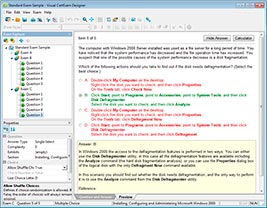
HOW TO OPEN VCEX FILES
Use ProfExam Simulator to open VCEX files
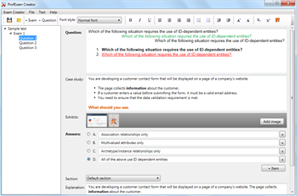
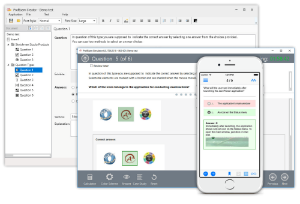
ProfExam at a 20% markdown
You have the opportunity to purchase ProfExam at a 20% reduced price
Get Now!